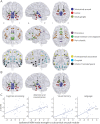Role of the Nucleus Basalis as a Key Network Node in Temporal Lobe Epilepsy
- PMID: 33441453
- PMCID: PMC8055321
- DOI: 10.1212/WNL.0000000000011523
Role of the Nucleus Basalis as a Key Network Node in Temporal Lobe Epilepsy
Abstract
Objective: To determine whether the nucleus basalis of Meynert (NBM) may be a key network structure of altered functional connectivity in temporal lobe epilepsy (TLE), we examined fMRI with network-based analyses.
Methods: We acquired resting-state fMRI in 40 adults with TLE and 40 matched healthy control participants. We calculated functional connectivity of NBM and used multiple complementary network-based analyses to explore the importance of NBM in TLE networks without biasing our results by our approach. We compared patients to controls and examined associations of network properties with disease metrics and neurocognitive testing.
Results: We observed marked decreases in connectivity between NBM and the rest of the brain in patients with TLE (0.91 ± 0.88, mean ± SD) vs controls (1.96 ± 1.13, p < 0.001, t test). Larger decreases in connectivity between NBM and fronto-parietal-insular regions were associated with higher frequency of consciousness-impairing seizures (r = -0.41, p = 0.008, Pearson). A core network of altered nodes in TLE included NBM ipsilateral to the epileptogenic side and bilateral limbic structures. Furthermore, normal community affiliation of ipsilateral NBM was lost in patients, and this structure displayed the most altered clustering coefficient of any node examined (3.46 ± 1.17 in controls vs 2.23 ± 0.93 in patients). Abnormal connectivity between NBM and subcortical arousal community was associated with modest neurocognitive deficits. Finally, a logistic regression model incorporating connectivity properties of ipsilateral NBM successfully distinguished patients from control datasets with moderately high accuracy (78%).
Conclusions: These results suggest that while NBM is rarely studied in epilepsy, it may be one of the most perturbed network nodes in TLE, contributing to widespread neural effects in this disabling disorder.
© 2021 American Academy of Neurology.
Figures





Comment in
-
Are We Inviting Another Attendee to the Temporal Lobe Epilepsy Party?Epilepsy Curr. 2021 Jun 3;21(4):270-272. doi: 10.1177/15357597211021080. eCollection 2021 Jul-Aug. Epilepsy Curr. 2021. PMID: 34690565 Free PMC article. No abstract available.
Similar articles
-
Abnormal functional connectivity of the posterior hypothalamus and other arousal regions in surgical temporal lobe epilepsy.J Neurosurg. 2023 Feb 17;139(3):640-650. doi: 10.3171/2023.1.JNS221452. Print 2023 Sep 1. J Neurosurg. 2023. PMID: 36807210 Free PMC article.
-
Neuroticism in temporal lobe epilepsy is associated with altered limbic-frontal lobe resting-state functional connectivity.Epilepsy Behav. 2020 Sep;110:107172. doi: 10.1016/j.yebeh.2020.107172. Epub 2020 Jun 14. Epilepsy Behav. 2020. PMID: 32554180 Free PMC article.
-
Thalamic arousal network disturbances in temporal lobe epilepsy and improvement after surgery.J Neurol Neurosurg Psychiatry. 2019 Oct;90(10):1109-1116. doi: 10.1136/jnnp-2019-320748. Epub 2019 May 23. J Neurol Neurosurg Psychiatry. 2019. PMID: 31123139 Free PMC article.
-
Impaired vigilance networks in temporal lobe epilepsy: Mechanisms and clinical implications.Epilepsia. 2020 Feb;61(2):189-202. doi: 10.1111/epi.16423. Epub 2020 Jan 4. Epilepsia. 2020. PMID: 31901182 Free PMC article. Review.
-
Graph theory findings in the pathophysiology of temporal lobe epilepsy.Clin Neurophysiol. 2014 Jul;125(7):1295-305. doi: 10.1016/j.clinph.2014.04.004. Epub 2014 Apr 21. Clin Neurophysiol. 2014. PMID: 24831083 Free PMC article. Review.
Cited by
-
Correlation Between the Functional Connectivity of Basal Forebrain Subregions and Vigilance Dysfunction in Temporal Lobe Epilepsy With and Without Focal to Bilateral Tonic-Clonic Seizure.Front Psychiatry. 2022 Jun 2;13:888150. doi: 10.3389/fpsyt.2022.888150. eCollection 2022. Front Psychiatry. 2022. PMID: 35722568 Free PMC article.
-
The role of the nucleus basalis of Meynert in neuromodulation therapy: a systematic review from the perspective of neural network oscillations.Front Aging Neurosci. 2024 Apr 8;16:1376764. doi: 10.3389/fnagi.2024.1376764. eCollection 2024. Front Aging Neurosci. 2024. PMID: 38650866 Free PMC article. Review.
-
Multimodal state-dependent connectivity analysis of arousal and autonomic centers in the brainstem and basal forebrain.bioRxiv [Preprint]. 2024 Nov 13:2024.11.11.623092. doi: 10.1101/2024.11.11.623092. bioRxiv. 2024. Update in: Imaging Neurosci (Camb). 2025 Jul 21;3:IMAG.a.91. doi: 10.1162/IMAG.a.91. PMID: 39605337 Free PMC article. Updated. Preprint.
-
Arousal and salience network connectivity alterations in surgical temporal lobe epilepsy.J Neurosurg. 2022 Jul 8;138(3):810-820. doi: 10.3171/2022.5.JNS22837. Print 2023 Mar 1. J Neurosurg. 2022. PMID: 35901709 Free PMC article.
-
Deep Learning Segmentation of the Nucleus Basalis of Meynert on 3T MRI.AJNR Am J Neuroradiol. 2023 Sep;44(9):1020-1025. doi: 10.3174/ajnr.A7950. Epub 2023 Aug 10. AJNR Am J Neuroradiol. 2023. PMID: 37562826 Free PMC article.
References
Publication types
MeSH terms
Grants and funding
- R01 NS075270/NS/NINDS NIH HHS/United States
- T32 EB001628/EB/NIBIB NIH HHS/United States
- R01 NS112252/NS/NINDS NIH HHS/United States
- F31 NS106735/NS/NINDS NIH HHS/United States
- T32 GM007347/GM/NIGMS NIH HHS/United States
- R00 NS097618/NS/NINDS NIH HHS/United States
- R01 NS108445/NS/NINDS NIH HHS/United States
- R01 NS095291/NS/NINDS NIH HHS/United States
- T32 EB021937/EB/NIBIB NIH HHS/United States
- R01 NS110130/NS/NINDS NIH HHS/United States
- T32 GM152284/GM/NIGMS NIH HHS/United States
- P50 HD103537/HD/NICHD NIH HHS/United States
LinkOut - more resources
Full Text Sources
Other Literature Sources
